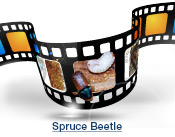| |
Spruce Beetle - Forest Health and Adaptation | |
| |
|
|
| |
|
|
| |  {GFX-ESRDx-ForestHealth-SpruceBeetle-Slide2.jpg}{GFX-ESRDx-ForestHealth-SpruceBeetle-Slide3.jpg}{GFX-ESRDx-ForestHealth-SpruceBeetle-Slide4.jpg}{GFX-ESRDx-ForestHealth-SpruceBeetle-Slide5.jpg} {GFX-ESRDx-ForestHealth-SpruceBeetle-Slide2.jpg}{GFX-ESRDx-ForestHealth-SpruceBeetle-Slide3.jpg}{GFX-ESRDx-ForestHealth-SpruceBeetle-Slide4.jpg}{GFX-ESRDx-ForestHealth-SpruceBeetle-Slide5.jpg}
Spruce beetles (Dendroctonus rufipennis [Kirby]) occur in endemic populations in white spruce stands throughout Alberta.
Outbreaks of the spruce beetle often originate from areas with blowdown, logging slash, or damaged standing timber. Spruce beetles breed in these areas and may attack and kill healthy trees.
Spruce beetle is common throughout Alberta, especially in areas with abundant mature spruce trees. Primary hosts include white spruce (Picea glauca [Moench] Voss) and Engelmann spruce (P. engelmannii Parry).
Signs and Symptoms
Look for the following signs and symptoms of spruce beetle infestation:
Crown
- Fading green, yellow-orange or red-brown over whole crown of mature trees.
Foliage/Buds
- Fading green, yellow-orange or red-brown needles.
Stem/Outer Bark
- Entrance holes on stem
- Pitch tubes
- Reddish-brown sawdust piles
- Woodpecker removal of bark
Wood/Inner Bark
- blue-coloured stain
- brown-black adults (4.5 -- 7 mm long) with reddish-brown or black wing covers
- presence of white grub-like larvae with light brown heads (up to 7 mm long)
- short egg galleries with larval galleries fanning out from egg galleries
Root Collar/Root
- blue-black coloured stain
- brown-black adults (4.5 -- 7 mm long) with reddish-brown or black wing covers
- galleries/tunnels
- pitch tubes
- presence of white grub-like larvae with light brown heads (up to 7 mm long)
Similar Damage
- Can be confused with other secondary bark beetles.
- Look for the characteristic gallery pattern that follows the grain of wood in the phloem and cambium tissues.
- Pitch tubes may be found on the bark surface.
- There is usually the presence of blue stain fungi.
- Spruce beetles prefer damaged, dying or freshly killed trees.
|
|
| |
|
|
| |
For more information about the content of this document, contact Devon Belanger.
This information published to the web on February 24, 2016.
|
|